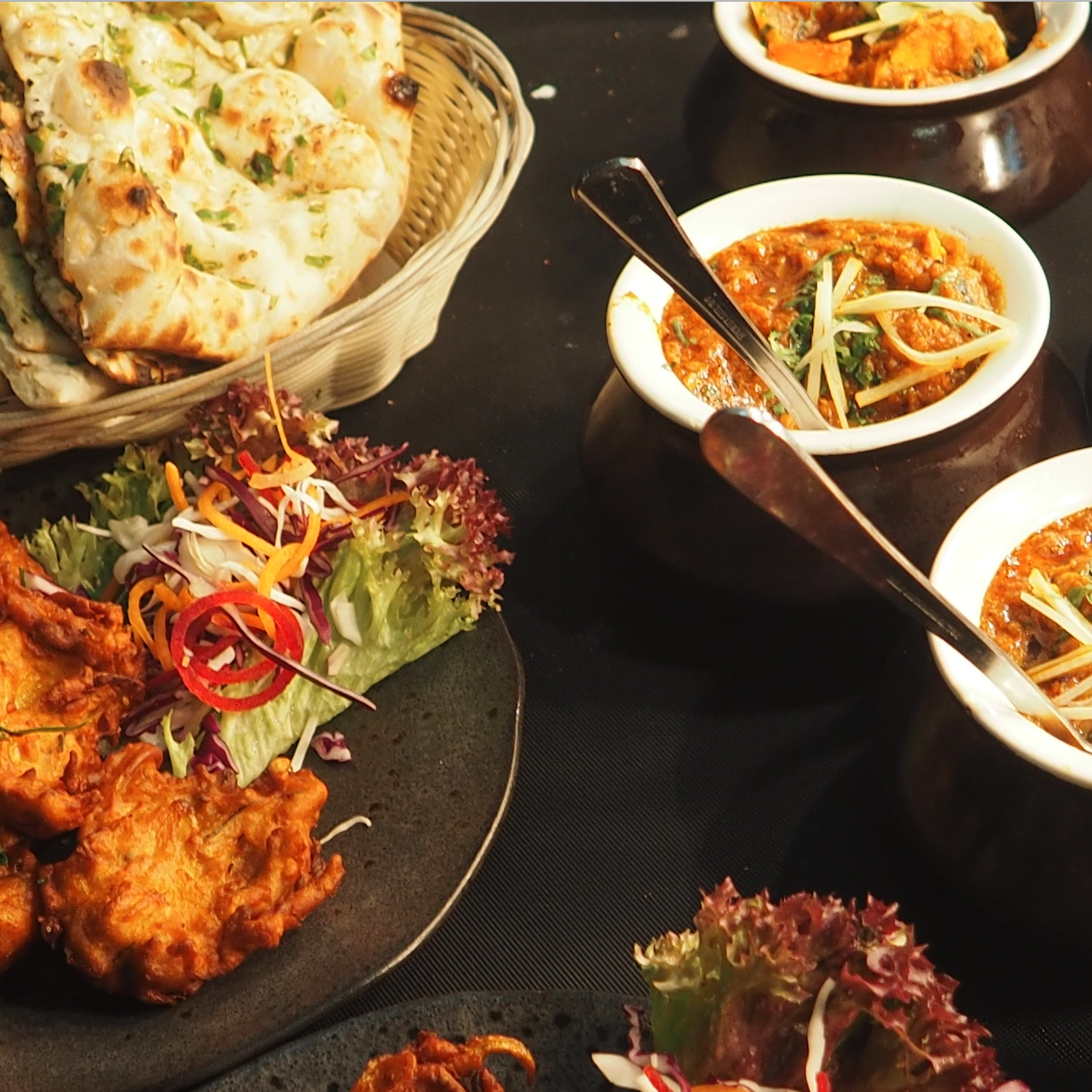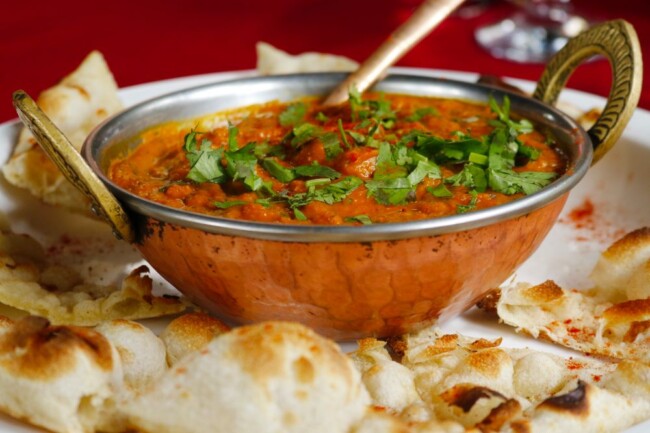When it comes to ordering at an Indian restaurant, many of us have had a moment where we stare at an expansive menu of curries, juicy grills, and hearty pastries, only to be confused with the myriad of food names and cooking techniques, before finally resorting to the good old chicken tikka masala, which is delicious in itself. But, Indian cuisine has a lot more to offer than chicken tikka masala. Understanding the food — not just the names of the dishes, but also the social context of them — will help you better navigate restaurant menus, explore a wider variety of food options, and appreciate what you eat. We have put together a glossary of dish names commonly seen on local Indian restaurant menus to help you make the decision. Keep reading for a guide to Indian food in Hoboken + Jersey City.

Indian Food Staples
Before you order, make sure you know what you’re getting first. Here are a few staple dishes in Indian cuisine:
Naan
This is the most common staple food in India. Essentially, naan is a flatbread baked in clay ovens, and the intense heat gives the bread a caramelized edge and an airy, stretchy texture. It’s often paired with baked or grilled meats. Naan can be served plain, but some cooks also brush it with ghee, and butter, or garnish it with garlic to spice up the flavor.
Roti
This is another extremely common bread. It is thinner and lighter than naan and is cooked over a griddle or skillet. The simple preparation method is easy for home cooks to master, thus roti is often served as a quick, no-fuss staple food.
Paratha
This is a deep-fried flatbread. To make it, wheat flour dough is folded with layers of ghee and then deep-fried in vegetable oil. It is fluffy, buttery, and extremely filling. It’s a popular snack or side dish. Wandering along the streets of North India, a traveler can easily find big, round puffs of paratha floating and sizzling in huge frying pans. In restaurants, parathas are most likely stuffed with potatoes, cheese, or meat.
Read More: A Guide to Authentic Mexican Restaurants in Hoboken + Jersey City
Gulab Jamun
This is an iconic Indian dessert made from milk solids. To make it, milk is boiled until only crumbly solids are left. Then the milk solids are kneaded into small round balls with a splash of milk, fried in ghee under low heat, and soaked in thick syrup. Yes, it’s a sugar bomb, but doesn’t taste overly sweet. The syrup is infused with fragrant cardamom and rosewater, which cuts the sweetness with a subtle citrusy and minty flavor and makes the dessert almost addictive.
Samosas
These are popular street snacks and appetizers in India. Savory fillings such as potatoes, peas, and sometimes minced meat are well cooked, loosely mashed, mixed with spices, and stuffed into paper-thin wheat wraps to make this savory snack. The whole thing is then deep-fried until golden brown. It is best served piping hot, accompanied by cooling dips (like chutney). Throughout the Indian subcontinent, samosas come in many different sizes, shapes, and fillings, reflecting the diverse agricultural and cultural practices in the country. They are also common in Indian restaurants in North America, with many meaty fillings available.
Korma
Korma is essentially meat or vegetables braised in a rich yogurt-based sauce. Korma has its roots in the Mulgal era, the Muslim dynasty from Central Asia that controlled a large part of India from the 16th to 18th centuries. And the heavy use of dairy and the variety of spices in Korma reflect the culinary style of that time. Today korma dishes are easy to find in restaurants in North India, and when well-executed, they can be extremely satisfying — succulent meat is braised in a delicate yogurt sauce for hours until meltingly tender. In North America, the dish tends to be slightly creamier and sweeter, with many vegetarian adoptions.
Saag
Saag is a curry made from leafy greens, such as minced spinach or mustard green, and well-seasoned with a variety of spices. Garlic is a must-use and gives the mild sauce a pleasantly pungent kick. The most typical saag dish is saag paneer, made with a creamy, tangy cubed fresh cheese (paneer). Sometimes it’s also cooked with chickpeas or meat.
Vindaloo
This is usually the spiciest meat dish on an Indian menu. However, it didn’t start this way. When Portuguese merchants first settled along the Goa coast, they brought their hometown dish carne de vinha d’alhos (meat marinated in wine and garlic) to their new homes. The Goan cooks localized the dish by substituting wine with palm vinegar. They also added a variety of local spices such as tamarind, cinnamon, and most importantly, red chili peppers. But for now, it was still a richly-seasoned, moderately spicy curry, often cooked with meat. When Bangladeshi immigrants opened curry houses in the UK in the 20th century, they somehow doubled down on the spice level, thus giving us the tongue searing, fiercely spicy vindaloo we get from Indian restaurants today.
Dal
Dal means lentil in Hindi. On a menu, it is a thick lentil stew (and boy is it tasty). To make dal, all kinds of lentils with varying levels of starch and sweet flavors can be used. Home cooks also play with the creamy texture and combination of spices to render it a hearty, smooth taste. No matter what’s in it, dal is always a perfect comfort food for cold weather.
Biryani
This is an iconic rice dish, consisting of layers of well-seasoned rice and meat. Someone traveling across the country of India will encounter dozens upon dozens of varieties of biryani, thanks to the region’s diverse climate and culture. Whatever the variety, the essential elements of biryani remains largely unchanged — meat, fluffy rice, various spices, and subtly flavored marinades such as yogurt to cool the palate. It’s a festive dish, often loaded with crunchy nuts, dried fruit, and caramelized vegetables. They are also easy to find in Indian restaurants in North America
Tandoori
The name derives from tandoor (clay oven) and refers to any dish baked in it. The recipes are extremely versatile, using all kinds of seafood, meat, and vegetables. The most common tandoori dish at an Indian restaurant in America is tandoori chicken — chicken rubbed with yogurt and spices, and baked until the outside is crispy and pleasantly smoky with the inside still moist and juicy.
Other common food menu items include:
Curry: The word curry itself doesn’t indicate any flavor, ingredient, or cooking style. It’s just a thick, saucy base in which protein or vegetables are cooked.
Tikka: Small chunks of a certain food. For example, paneer (fresh cheese) tikka means small chunks of cheese.
Masala: Mixed spice. For example, masala chai is tea with mixed spice.
Chutney: Chutney refers to a sauce or dip. There are no fixed recipes or usages, but the ingredients usually have a bright taste profile. The chutney usually served in Indian restaurants is made of pickled fruit (such as mango), herbs (such as mint), or yogurt.
Chaat: Chaat can be served as a snack, an appetizer, or a side dish. Again, there is no fixed recipe, but it usually consists of a starchy base (often fried), a tangy and/or spicy condiment, some well-flavored vegetables, and it’s often sprinkled with crunches to enhance the texture.
Where to Get Indian food in Hoboken + Jersey City
Here are some restaurants where you can get authentic Indian food in Hoboken + JC:
Amiya | 101 Hudson Street, Jersey City
The restaurant serves a modern north Indian fare with a light touch of fine dining. Crowd-pleasing options such as curries and samosas are served, but the menu also offers unique dishes less seen elsewhere. There’s Dum Aloo, a Kashmiri-style stew made of cheese-filled baby potatoes poached in a creamy gravy. Or the egg curry, marinated in a delicious ginger and chili sauce. Carnivores should order the tandoori platter. Dig into the shish kebabs first flavored with assorted spices and herbs.
Biryani Pot | 824 Newark Avenue, Jersey City
This is a well-loved Hyberabadi-Indian chain known for its Biryani dishes. Return customers like the well-seasoned meat dishes and flavorful rice options. Note, the portions are very big.
Chaska | 1297 Paterson Plank Road, Secaucus
While this spot is now in Secaucus, it was formerly located in Jersey City, and it’s too good to exclude. This is cozy restaurant has various vindaloos (try the fish vindaloo for a seriously tasty experience), along with many other North Indian-style dishes such as chicken korma. This spot is also known for its huge weekday buffets.
Clove Garden of India | 353 3rd Street, Jersey City
This Indian Frontier spot opened in 2020 and quickly became a local staple. Serving up a vast array of vegetarian starters — from tamarind eggplant (crispy eggplant slices with chickpeas, mint, and tamarind) to lasoon gobi (cauliflower florets tossed in sweet chili garlic sauce). Of course, there are plenty of non-vegetarian eats, too, like chicken lollypop and lamb pepper fry. Clove Garden of India fuses traditional Indian cuisine with a modern atmosphere.
Curry Up Now | 91 Washington Street, Hoboken
Curry Up Now was established back in 2009 by Akash Kapoor and his wife Rana. What began as a California food truck, quickly turned into the largest and fastest-growing Indian fast-casual concept in the U.S. — and while it is a franchise, the Hoboken location is owned by local franchisees, Pritesh Benjamin and Tejavsi Patel. On the menu you’ll find, fan-favorites like Quesadillix (quesadillas), Sexy Fries, and the Naughty Naan. At Curry Up Now, you’ll also find tikka masala burritos and the Deconstructed Samosa, a dish described as “an inside out phenomenon loaded with chana, pico kachumber, chutneys, mini samosas.”
Karma Kafe | 505 Washington Street, Hoboken
This is one of Hoboken’s oldest Indian restaurants, with a large menu featuring many of India’s regional dishes. The tandoori dishes are particularly interesting here, with subtly different but equally flavorful marinades for different cuts of meat, paneer, and vegetables.
Laree Adda | 287 Grove Street, Jersey City
This Indian + Pakistani eatery blends the ethnic cuisines of two “colorful nations” to serve a menu that packs a mighty flavorful punch. There’s an array of platters, curries (even vegan), and canteen-style items too. HG pro tip: if you order the Mix Grill, the staff will cook it at your table.
Pariwaar Delights | 827 Newark Avenue, Jersey City
The restaurant has made a name for itself with its gorgeous biryani. The fragrant dish uses eighteen different spices, some shipped directly from India, and is cooked in the traditional “Hyderabadi dum style”. Rice and meat (or vegetables) are mixed with spices and layered in a clay pot and steamed with the lid sealed, so the fragrance and the flavors get fully integrated together. The taste is bright, warm, and rich at the same time — a complex balance of the subtle heat of the spices, the umami of the meat, and the sweet, buttery aroma of the rice makes each bite delish. Other south Indian specialties, such as chicken Chettinad, are also worth an order.
See More: Where to Take Your Parents Out to Eat in North Jersey
Rasoi | 810 Newark Avenue, Jersey City
This is a long-standing neighborhood eatery famous for its buffets. Other than a wide variety of authentic traditional dishes, people love this place for its pani puri chaat, consisting of a deep-fried crispy crepe stuffed with flavorful fillings such as yogurt and chickpeas.
Sapthagiri | 737 Newark Avenue, Jersey City
This restaurant serves vegetarian North Indian Thali, consisting of a dairy dish, chana (chickpea) masala (spiced curry), lentil soup, roti, and a dessert. Another must-try is their giant papadi chaat, with crackers, potatoes, drizzled with yogurt, and spicy chutney.
Shadman | 293 1/2 Grove Street, Jersey City
This is a small restaurant serving simple Pakistani and Indian dishes. They are known for the tasty naans, parathas, and hearty samosas, all served in a variety of flavors.










